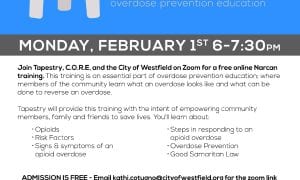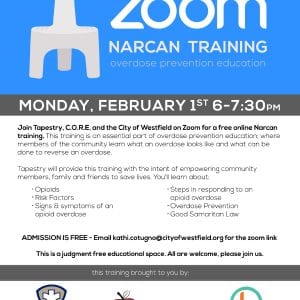WESTFIELD – State Police reported recently that 185 deaths have resulted in the past four months from heroin overdoses throughout the Commonwealth – Taunton alone saw 70 heroin-related deaths – and two of those deaths happened in Westfield.
There might have been more in the city but for Narcan, a potent pharmaceutical weapon against overdoses, which has been available to EMS first responders in the city since the Westfield Fire Department initiated paramedic services on the city’s ambulances in the late 1990s.
Narcan is a brand name for naloxone, a medication which initially was administered by intravenous injection and has recently become available in a nasal spray preparation.
The drug works because heroin overdoses cause the body to ‘forget’ to breath and the drug interrupts that mechanism and ‘reminds’ the body to breath again, until the drug wears off in a bout a half an hour.
Deputy Fire Chief James Kane, the Emergency Medical Services coordinator at the city’s fire department, said that the drug is “unbelievable, it works in a minute.”
“You give it to him (an overdose patient) and bang! You’ve got him right back,” he said.
Kane said that he first encountered the medication when he was a young firefighter and worked on an ambulance crew.
He said that his ambulance responded to a heroin overdose emergency at a South Maple Street address before Narcan was among the supplies on city ambulances.
Kane said that the patient “hardly had a pulse” but, since the hospital was “right around the corner,” the emergency medical technicians did not spend any time treating the patient but raced him to the emergency room.
There, Kane remembers, the emergency room doctor injected Narcan.
“He hit him with that and within 60 seconds it was like nothing happened,” Kane said. “I was amazed. I thought he was dead.”
The drug became available to Westfield ambulance crews when the city’s EMS system was upgraded to include paramedics on the ambulance crews, who are trained to perform IV injections.
Capt. Seth Ellis, a paramedic and the department’s training officer, said that the drug was used 36 times in 2013 by city paramedics and, to date in 2014, nine times.
However, Ellis quickly pointed out, he has done no statistical analysis of the numbers so, although it might appear that the rate of use is increasing, it is possible that there may be seasonal anomalies which might, for example, reflect an increase in use of Narcan in the winter.
Ellis said that the paramedics now carry the nasal preparation, as well as hypodermics of the drug.
He said both preparations include the same medication but the nasal variant does require a larger dose and takes a little longer to be effective.
‘It’s not as quicka s an IV injection but it’s pretty quick,” he said and explained that “They don’t actually inhale it. It’s absorbed by the mucus membranes of the nose” and said that the big advantage is that “there’s no needle.”
Ellis said that needles can be hazardous, especially when dealing with a patient who may move or react in unexpected ways while a paramedic is in contact with the patient and holding a needle which might accidently be jabbed into the wrong skin.





